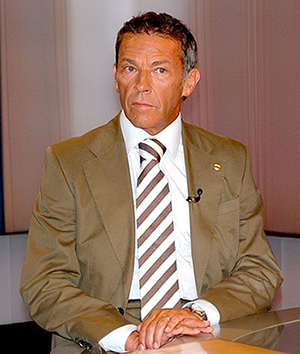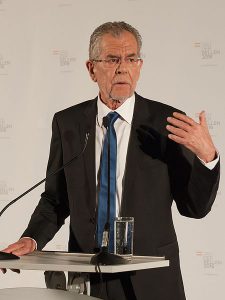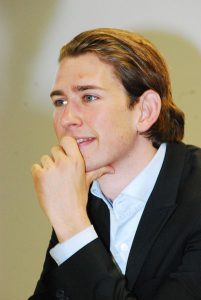Election Analysis
Austria's Snap Election and the End of the Grand Coalition
The election on October 15 could see the FPÖ enter government for the first time in nearly 20 years. How did we get here?

It’s been a busy year of voting across Europe. Elections in the Netherlands, France, and Germany have dictated even the international news. On October 15, Austrians will go to the polls. A prosperous country at the heart of Europe, it has become used to relatively predictable politics. Two parties – the Social Democrats (SPÖ) and the People’s Party (ÖVP) – have dominated political life since the end of WW2. Yet Austria is also home to one of Europe’s most successful populist radical-right parties, the Freedom Party (FPÖ).
Comparisons between the FPÖ and the French National Front or German Alternative for Germany are unavoidable. Even though these parties share more enemies than policies, talk of a ‘populist international’ movement is now rather crudely used to explain their rise. It’s true that the political, economic, and social shifts present in Austria have been visible across the EU. Parties have converged, markets have opened up, post-materialism is on the rise. But the FPÖ’s success is also a product of Austria’s very specific history and more recent political dynamics. While cross-continent crises – migration and economic – have played a role, the FPÖ made an impact well before both.
The election on October 15 could see the FPÖ enter government for the first time in nearly 20 years. How did we get here?
Proporz
Before WW2 Austria grappled with left-right internal divisions. Scars from the 1934 civil war remain visible in parts of Vienna. To avoid future confrontation, a new system of political power-sharing was rolled out. It became known as Proporz. The idea was that two parties – the centre-left SPÖ and centre-right ÖVP – would rule together in grand coalition. Consensus was to replace competition. A system of ‘social harmony’ was sought, even if it suppressed political disagreement. It set the scene for post-war Austria. The SPÖ and ÖVP have dominated politics ever since, governing together in coalition for much of that time. The influence of both parties runs deep; a network of patronage touches everything from schools and hospitals to unions. But by the 1980s, cracks in this system began to show. A third party under the leadership of the charismatic Jörg Haider emerged. That party was the FPÖ.

The FPÖ shot to fame after Mr Haider became leader in 1986. Originally formed in 1956 by ex-Nazis, the party had become relatively moderate until Mr Haider transformed it. He was an unpredictable, brash and controversial figure. He ran on a nativist, populist, and authoritarian platform of “Austria First.” He described non-native Austrians as social parasites, blaming them for the country’s social and economic problems. He sought to divide society into “the people” and a corrupt, unaccountable elite. He would also stoke conflict by flirting with language that trivialised Nazism at a time when Austria was still coming to terms with its own past. He would later apologise, but Mr Haider seemed to revel in the controversy. And much like the press coverage of Marine Le Pen in France or Geert Wilders in the Netherlands today, the Austrian media lapped it up. The FPÖ maintained a high profile and a stage to push their policies into the political mainstream.
But the FPÖ’s greatest asset was its opposition to Proporz. With an under-developed party system and few options for dissent, most of it went to Mr Haider. The SPÖ and ÖVP tried to isolate the party but failed. Instead of pushing it to the margins, they simply elevated its status. The FPÖ was also aided by broader political, economic, and social changes in Austria. Like elsewhere in Europe, traditional voting blocks began to erode and fragment. New cleavages in Austrian politics emerged, not defined by the post-war monopolies. Frustration with a tired status-quo began to bubble. This would happen as Austria became an EU member in 1995. While the population was overwhelming positive about joining, many were concerned about the effects the Union would have on the country’s long held neutrality, and its small but successful economy. Instead of having an open discussion on EU issues, the SPÖ and ÖVP evaded debate and buried criticism. Their fractious grand coalition struggled to maintain momentum. Everything would change come the 1999 elections.
The Breakthrough
In 1999’s parliamentary election, the FPÖ came second with 27 per cent. Running on an anti-immigration, anti-EU enlargement, and anti-Proporz ticket, the party entered into a coalition government with the ÖVP. It didn’t end well. There were protests across the country and Austria became increasingly isolated within Europe. A shocked EU imposed diplomatic sanctions. These didn’t last long – after 7 months they were scrapped. They also backfired. Many Austrians were angered by what they saw as the EU interfering in their domestic politics. Mr Haider’s popularity was given a boost. So was any anti-EU sentiment. But, regardless of sanctions, the coalition was plagued by infighting and collapsed in 2002. The chaos saw the FPÖ’s support plummet. A disgruntled Mr Haider broke away to form a new party. He died in a car crash in October 2008.

The SPÖ and ÖVP never recovered. Their domination of a two party system was over. A more professional and slick FPÖ would bounce back under a new leader, Heinz-Christian Strache, who manoeuvred the party further to the right. It became increasingly anti-Islam. It attacked “corporate Europe.” It also campaigned on popular issues like welfare, pensions, regulation, and tax. FPÖ posters with “our money for our people” appeared across the country in the run-up to the 2013 parliamentary elections. The party did well. The SPÖ and ÖVP didn’t. They saw their worst result in post-war Austria. Together, they had once taken more than 90% of the vote, now they barely secured a majority. While they continued to govern, “grand” no longer seemed an appropriate description of the coalition. Both parties promised to make amends. The leader of the SPÖ echoed remarks made by the ÖVP. “This result is a wake-up call…We can’t simply go on as before.”
But in many ways it was too late. The unique coalition system that had brought stability to the country had run out of steam. It had come to represent stale gesture politics, dominated by infighting and inertia. Political disillusionment amongst the public grew. The next big test would be the 2015 migration crisis. Initially the government supported Berlin’s “welcome culture.” But after struggling to logistically deal with new arrivals – not to mention its own mismanagement – it made a 180 degree turn. Rhetoric soon focused on the threat from migration. Austria’s borders were tightened. Schengen was suspended. This opportunistic flip-flopping made the government look indecisive and played into the hands of Mr Strache and the FPÖ, who were already making political capital from portraying the ruling coalition as weak and directionless. This crisis would become the backdrop to the country’s 2016 presidential election.
A New President
These elections underlined the extent to which Austrian politics had changed. Before 2016, presidents had come from one of the grand coalition parties (or been an independent candidate endorsed by one of them). Last year, the SPÖ and ÖVP candidates were eliminated in the first round of voting. Instead, the final run-off was between the FPÖ’s Norbert Hofer and the independent (but not endorsed), ex-leader of the Green party – Alexander Van der Bellen. After a tight race Mr Van der Bellen was pronounced the winner with 50.3 per cent. But any relief within Austria and across Europe was short-lived. The result was overturned by the constitutional court on the grounds of irregularities – it would need to be done all over again. Mr Hofer would lose for a second time, by a (slightly) larger margin. He misjudged the country’s mood as his campaign became increasingly divisive. By election day he had alienated many of those undecided voters needed to win.

The election of a populist radical-right head of state would have been a political earthquake. While the presidency is mainly ceremonial, its powers can still disrupt and frustrate a government. Mr Van der Bellen’s win provided some much needed respite for an already shaky coalition. It also showed that dissatisfaction and exhaustion with the current system doesn’t just manifest itself as support for the FPÖ. Mr Van der Bellen ran an inclusive, liberal, and unashamedly pro-EU campaign. If nothing else, it was encouraging that Austria, twice in a row, had elected the ex-leader of the Green party. The stark difference between both candidates was also revealing. It reflected the evolving divide across Europe between the politics of open and closed, global and national.
After the election, the SPÖ and ÖVP promised to keep their governing coalition together until the parliamentary vote in 2018. This would provide the country with the time and stability to implement promised reforms. With the FPÖ leading in the polls, both parties admitted they had work to do. Their bungled response to the 2015 migration crisis, a struggling school system, a still stuttering economy, and concern over unemployment; all these were putting significant pressure on the government. But instead of tackling their waning legitimacy, the parties merely returned to bickering and squabbling. Internal disagreements and rising tensions left the coalition paralysed. After resignations and reshuffling within the ÖVP, the government essentially collapsed. Snap elections were called for October 15.
The End of the Grand Coalition

Predicting elections is never straightforward. But another grand coalition between the SPÖ and ÖVP looks unlikely. An already dysfunctional relationship seems to have reached a tipping point. Both want to be in power, just not with each other. Both have also struggled to carve out an individual and fresh narrative for this month’s vote. The ÖVP has pinned its hopes on likely new chancellor, Sebastian Kurz. Young, ambitious, ruthless, he took over the chairmanship of the party earlier this year. His popularity shows in the polling numbers. The party has leapfrogged the SPÖ and FPÖ into first place. Mr Kurz says he wants to remodel the ÖVP as a movement. He wants the party to field independent, but endorsed, candidates (some with no previous political experience) in the election – a move echoing President Macron’s En Marche! campaign. The scandal-hit SPÖ, and current Chancellor Christian Kern, are trying to remain positive. Mr Kern has continued to push his modernisation strategy, targeting job creation and investment. But with the party trailing in the polls, many fear defeat come election day.
If neither party gain a majority on their own – and if they rule out a grand coalition together – the alternatives are thin on the ground. Other parties like the Greens or the liberal NEOS are too small. That leaves the FPÖ as the only other partner. The ÖVP hasn’t ruled out a possible deal. Nor has the SPÖ. It has even dropped (with caveats) a 30 year self-imposed ban on working with the party in anticipation. The FPÖ’s support may have slumped recently, but much of this is due to others parroting parts of its platform. Mr Kurz is the most notable offender, taking a hard line on immigration and integration. He has dominated the discussion of both issues so much – whether it is calling for the end to economic migration or claiming women are being paid to wear veils – that the FPÖ even accused him of plagiarism. Whatever happens on October 15, Mr Strache’s party has already shaped much of the political debate.
This month’s election will highlight the failings of Austria’s two most established parties. The grand coalition has taken the electorate for granted. Protected by a system that offered little incentive to revitalise politics, its faux stability has relied on patronage as much as principle. There is no doubt that the SPÖ and ÖVP watched over a prosperous country for decades. But, as their monopoly on power fractured, they did little to try to fix it. And, like in other European countries, politics fragmented and realigned. Parties emerged which took advantage of eroding behaviours, connections and relationships. The FPÖ has grown to be one of Europe’s most successful radical-right parties. While any FPÖ success will likely be framed as a consequence of migration, the party’s roots go back further and deeper. That it can contest a presidential election like it did last year shows how normalised the FPÖ has become in Austrian politics. The SPÖ and ÖVP must take their share of the blame. Both parties don’t appear to have learned any lessons. It may now be too late.





